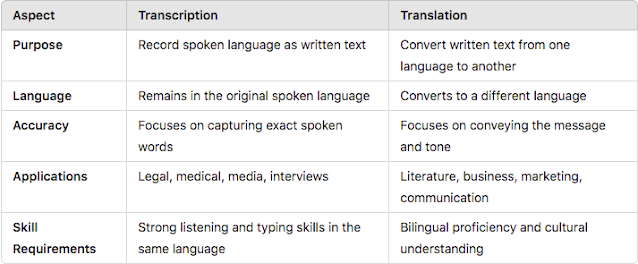 |
| Understanding the Difference Between Transcription and Translation |
A Comparative Insight with Examples in English, French, and Arabic
Introduction
In linguistics and language services, transcription and translation are two essential but distinct processes, each serving a unique purpose. Although they may appear similar at first glance, they fulfill different communication needs. This article explores the definitions, purposes, and applications of both, supported by practical examples in English, French, and Arabic.
1. Definition of Transcription
Transcription is the process of converting spoken language or audio content into written text. It’s a precise representation of words as they are spoken, without altering the language. Transcription is crucial in fields like media, legal proceedings, medical documentation, and interviews.
Example in English:
A podcast episode on technology is transcribed word-for-word into a text document, making it accessible to those who prefer reading or have hearing impairments.
Example in French:
In a French court, a stenographer transcribes the proceedings verbatim, preserving the exact language used for legal accuracy.
Example in Arabic:
In a meeting, an Arabic-speaking participant’s words are transcribed into Arabic text. This transcription serves as a record of what was said, without translating it into another language.
2. Definition of Translation
Translation, on the other hand, involves converting written text from one language to another while preserving the original message, tone, and intent. Translation is essential for cross-cultural communication, helping individuals and businesses connect globally.
Example in English to French:
An English novel is translated into French, allowing French-speaking readers to enjoy the story as if it were originally written in their language.
Example in Arabic to English:
A historical Arabic document is translated into English to provide historians worldwide with insights into its content and context.
3. Key Differences Between Transcription and Translation
4. Examples to Illustrate the Differences
1. English Audio Transcription Example:
In an academic lecture recorded in English, the transcription provides a verbatim text version for students who missed the lecture or need to reference the details.
2. French Audio Transcription Example:
A French interview with a public figure is transcribed in French for media publications to ensure accuracy.
3. Arabic Audio Transcription Example:
Arabic medical consultations are transcribed to document patient discussions and diagnoses precisely.
English to French Example: A company’s product manual is translated from English to French to serve their Francophone customers in Canada and Europe.
French to Arabic Example: A French legal document is translated into Arabic for a client needing legal services in an Arabic-speaking country.
Arabic to English Example: An Arabic research paper is translated into English, allowing international scholars to engage with its findings.
5. When to Use Transcription vs. Translation
Understanding when to use transcription or translation depends on the end goal:
- Use Transcription when you need a record of spoken content in its original language, such as in interviews, podcasts, or court proceedings.
- Use Translation when you need to make written content accessible to speakers of another language, such as with marketing materials, academic texts, or corporate communications.
Conclusion
Both transcription and translation are invaluable in bridging communication gaps, though they serve different functions. Transcription captures spoken language accurately in text, while translation allows a message to transcend linguistic boundaries. Recognizing when to apply each process is crucial for effective communication in an increasingly globalized world.

